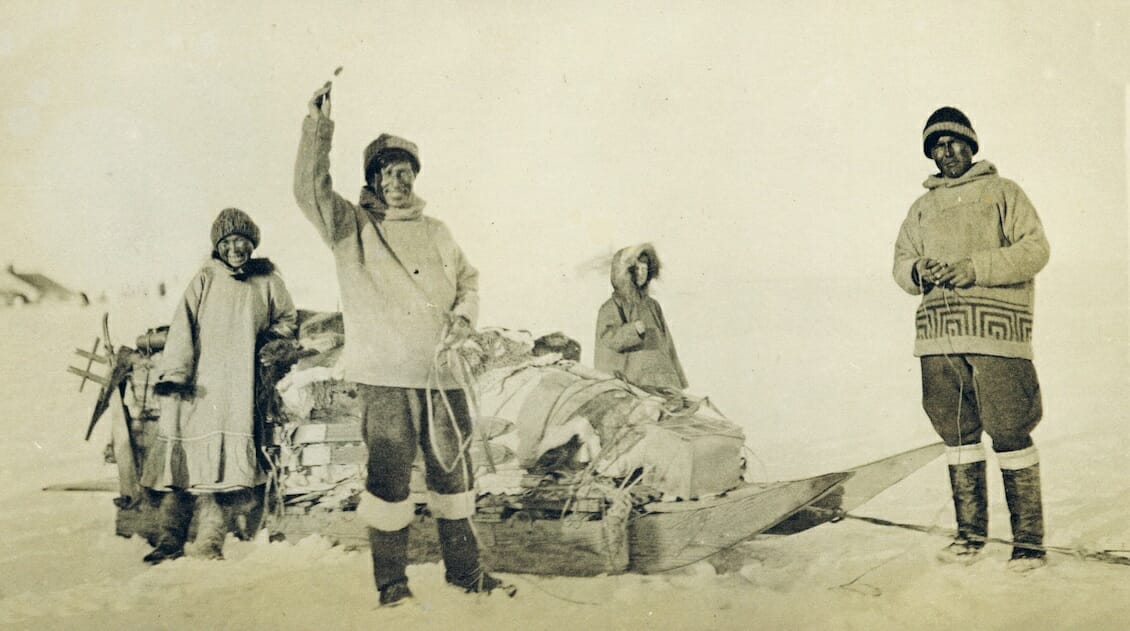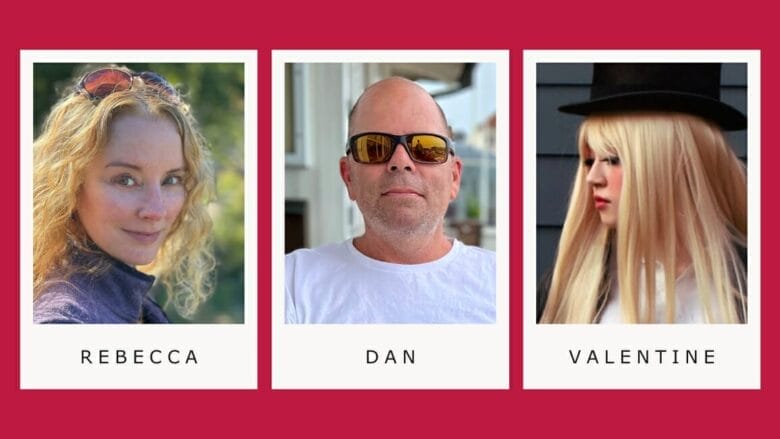The article was originally published in April 2021 in Danes Worldwides printed members’ magazine, DANES.
Text: Kenn Harper
It was a cold autumn day on the shores of the Bering Strait. The traveller gazed out over the pack ice, back towards the American continent from whence he had come. He had travelled a long way, in time and space, all the way from Greenland, to stand on the shores of this narrow body of water named after a fellow Dane. Knud Rasmussen had accomplished his dream of over a decade – he had traversed the roof of the American continent, visiting isolated Inuit tribes along the way. Here, he had collected legends and life stories – what he called intellectual culture – along with artifacts, implements, tools, and clothing – material culture – to take back to the National Museum of Denmark in Copenhagen. Save for getting home, the grand journey, the final stretch of which had been accomplished by dog sled with only two Greenlandic Inuit companions, was now at an end.
Knud Rasmussen was born in Jakobshavn (now Ilulissat) in Greenland to a Danish pastor and his part-Greenlandic wife. His first language was Kalaallisut, the language of the local people, and his childhood playmates were Inuit. He learned to drive a dog sled by the age of eight. Eventually, though, he went away to Denmark for formal education, after which he worked as a journalist. But the Arctic beckoned him back. “My life’s course led inevitably toward Arctic exploration,” he wrote. In 1902 he took part in the Danish Literary Expedition to the isolated area north of Melville Bay where the little-known Inughuit – the Polar Eskimos as they were then called – lived. Wintering there, he immersed himself in their dialect, legends, and lore. He was hooked. The Arctic would be his life. The study of the Inuit would be his life’s passion.
“As a result of Rasmussen’s, Birket-Smith’s and Mathiassen’s work, the largest collection of Canadian Inuit material culture is not in Canada but in Copenhagen”
There remained, however, the matter of how to finance a life of exploration and study. In 1909 he returned to northern Greenland to assist the Danish Mission Society and the Greenlandic Church Cause in establishing the first mission to the Inughuit at North Star Bay. That year American Robert Peary announced his claim to have found the geographic North Pole, his on-and-off quest for the past 18 years. He would be coming to Greenland no more and the Inughuit, who were heavily dependent on him, would have no source of trade goods, hunting equipment and ammunition. Rasmussen saw his chance. The following year he returned with his friend Peter Freuchen to establish a private trading post, the Thule Station. The premise behind it was that the profit from furs and ivory would finance the pair’s geographic and scientific explorations.
At about that time Rasmussen began to formulate his plans for a grand investigation into the origins of the Inuit race, an endeavour that would take him to the central Canadian Arctic in a search for Inuit largely untouched by the hand of civilization.
While working on his plans, he took part in four so-called Thule expeditions in various parts of Greenland. At the same time he wrote of his experiences with the Inuit in an effort to make his name known to the public and the scientific community. A committee of Danish scholars and businessmen meanwhile helped manage the financial affairs of the trading station and the expeditions.
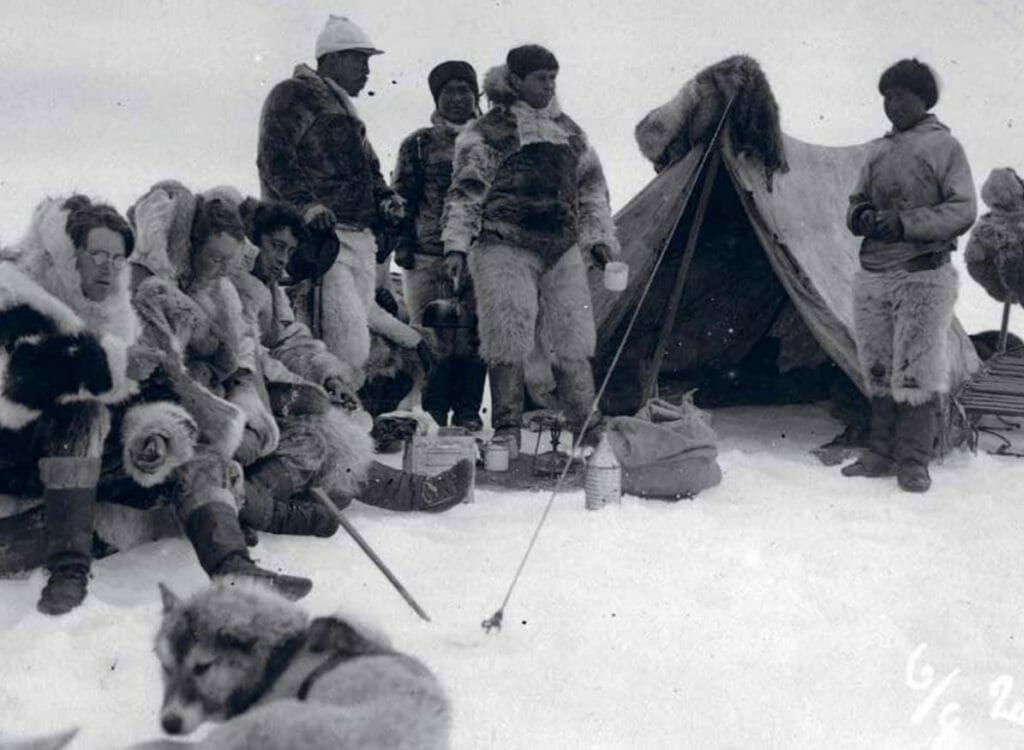
By 1921 he was ready. With six Inughuit hunters and seamstresses as support, a southern Greenlander as secretary, and four Danish scientists and assistants, including his friend Freuchen, he left Greenland on the ship Søkongen for northwestern Hudson Bay, where he established his headquarters on an island he named Danske Øen (Danish Island) near present-day Naujaat (formerly Repulse Bay).
Therkel Mathiassen busied himself with archaeological excavation, finding evidence confirming the existence of a previous culture ancestral to the Inuit. Freuchen was engaged in cartography and biological studies. Helge Bangsted was a general assistant and occasional secretary, and Jacob Olsen, a Greenlandic catechist, was the secretary and interpreter to those Danes who spoke no Inuktitut (Eskimo). Kaj Birket-Smith and Rasmussen attended to ethnology and documentation of what Rasmussen called the “intellectual culture” of the Inuit.
It was February of 1922 when Rasmussen and his team met the first Canadian Inuit. He was relieved to find that he could understand their language with relative ease. In short order he met an impressive man named Aua, and his talkative wife Orulo, who became the central characters in Rasmussen’s magisterial account, The Intellectual Culture of the Iglulik Eskimos.
Rasmussen had the soul of a poet, and he revelled in collecting the stories of the Inuit, especially their religious beliefs and the practices of the shamans. From Aua he learned:
“We fear the weather spirit of earth that we must fight against to wrest our food from land and sea… We fear dearth and hunger in the cold snow huts. We fear Takannakapsaaluk, the great woman down at the bottom of the sea that rules over all the beasts of the sea.”
From Igjugaarjuk, a shaman of the inland Caribou Inuit, he gleaned that true wisdom could only be found “far away from people, out in the great solitude, and it is not found in play but only through suffering. Solitude and suffering open the human mind…”
In March of 1923 Rasmussen left Danske Øen with a young Inuit man, Qaavigarsuaq, and a widow, Arnarul unnguaq, to begin his great sled journey westward. They would visit Inuit across the top of North America all the way to Alaska. They passed their first summer with the isolated Nattilik Inuit, a community less influenced by the outside world than any Inuit Rasmussen encountered. There he met the hunter-poet Orpingalik who told him, “I have many songs. All my being is song, and I sing as I draw breath.” Rasmussen listened, and wrote.
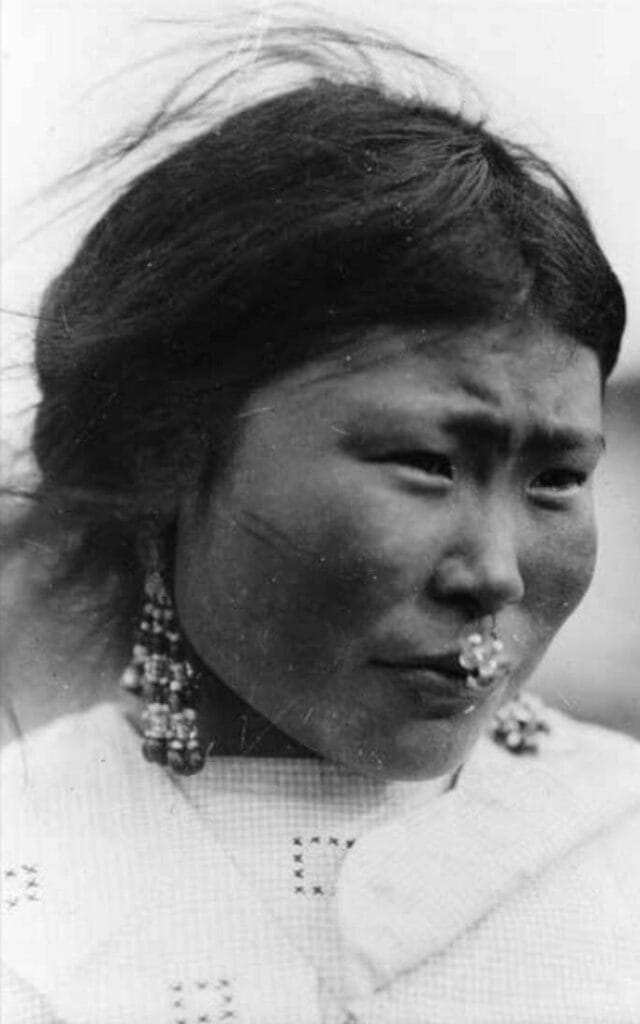
(© Arktisk Institut)
They wintered among the Copper Inuit in the western Canadian Arctic. In the spring they continued on to the Mackenzie Delta and then into Alaska, all the while travelling by dog sled. But there they switched to coastal boats to reach the former goldrush town of Nome, a crossroads for Inuit from many parts of Alaska. Rasmussen chartered a schooner and crossed to Siberia. But the new Soviet authorities were flexing their muscles, and he had no visa; he was turned back, staying only one night and part of the next day.
Nevertheless he had accomplished his dream. He had visited the most isolated Inuit in North America and recorded for all time their culture at the last possible moment before a wave of change swept over the Arctic. He was the last of the old style dog sled explorers. He recognized this and once stated, “From my heart I bless the fate that allowed me to be born at a time when Arctic exploration by dog sledge was not yet a thing of the past.”
With modesty, he proclaimed in the introduction to his best-selling popular book Across Arctic America that “The Eskimo is the hero of this book.” He felt that much work yet lay ahead of him; “One can never finish exploring a people,” he remarked. The work of the Fifth Thule Expedition placed Denmark firmly in the forefront of Inuit studies – indeed, “Eskimology” became an important field of study. As a result of Rasmussen’s, Birket-Smith’s and Mathiassen’s work, the largest collection of Canadian Inuit material culture is not in Canada but in Copenhagen.
Back in Denmark, Rasmussen worked for some years on writing up the results of the expedition. Two more Thule expeditions followed. On the last, to East Greenland, he fell ill and was evacuated to Denmark where he died on December 21, 1933. He was only 54.
Fifth Thule expedition – 100th anniversary photo exhibition
The Fifth Thule Expedition tells the story of the common origin and internal affinity of Inuit across Greenland, Canada, Alaska, and Siberia. It reflects life in a part of the world that has sometimes been considered marginal, frozen, isolated, or even deserted. In fact, it is a region of beauty, poetry, viability, entrepreneurship and unique human insight.
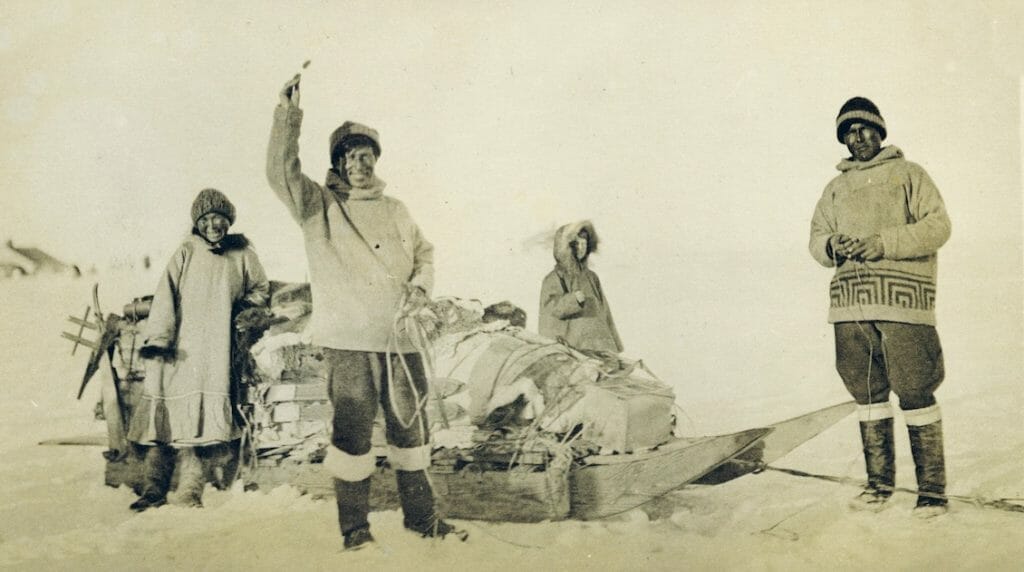
Half of the members of the expedition team were Inuit, the rest were Danish scientists. Travelling more than 6,000 kilometres on dogsleds and hunting and eating with their hosts while communicating with them in their own languages, the expedition met the Arctic people at close range. In this way, they have provided us in posterity with glimpses of a completely unique exchange between visitors and their Inuit hosts.
During the anniversary years, a photo exhibit about the fifth Thule Expedition will be available to Danish Embassies and Foreign Embassies in Denmark.
A multispronged visual narration of the expedition, it will also have a parallel track on contemporary Arctic issues. The exhibition will be structured according to themes such as ‘An InuitDanish expedition’, ‘Inuit are one’, ‘A world of Crafts’, ‘’Amulets and tatoos’, ‘Evil spirits, capes of protection, and borrowed talents’, ‘ Angakut – the shaman family of Aua and Orulo’, ‘Amulets – shields against invisible evil’, ’The long sled journey’, ’Creatures of the sea’, ’Nunivak myths and masks’ and ‘A white world in transition’. Possibly, a cocurated soundtrack will be made available in English.
From August 2021, the exhibition can be requested from a website that is currently under construction and is expected to be available as of June 1, 2021: www.5Thule100.dk.
The exhibition is a part of a series of events organized individually and coordinated by an anniversary steering comitee, 5Thule100, constituted by representatives from the House of Knud Rasmussen, the National Museum of Denmark and the Danish Arctic Institute. Under the protection of His Royal Highness Crown Prince Frederik of Denmark, the celebration begins in 2021, marking the 100th anniversary of expedition take off, and it continues with several cultural events for the following three years. The Danish Agency for Culture and Palaces and Aage and Johanne Louis-Hansen’s Foundation have financially supported the coordination and exhibition.

